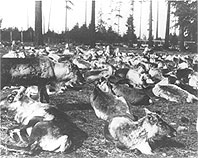
|
|
|
|
1893: Jackson's advertisements in Scandinavian-American newspapers for Laplanders or others who are skilled in reindeer management receive 250 replies. One of the respondents, William Kjellman, is hired as superintendent at Teller Station. He is a Kven [a descendant of Finnish immigrants to Norway who have intermarried with Sami for many generations] from Madison, Wisconsin who has worked in Finnmark as a reindeer herder and speaks the Sami language. Tollef Brevig, a teacher and missionary from Crookston, Minnesota, is hired as assistant superintendent. William [W.T.] Lopp, a white teacher, is hired as superintendent of the Cape Prince of Wales reindeer station and mission. There are now 180 reindeer at Bering, but the Alaska Commercial Company abandons its lease of the island because it is too far from the mainland. 1894: Jackson receives $6,000 from Congress to fund the Reindeer Project, the first of $207,500 he will receive between 1894 and 1904. Jackson receives $6,000 from Congress to fund the Reindeer Project, the first of $207,500 he will receive between 1894 and 1904. In February Jackson sends Kjellmann to Kautokeino, Norway to recruit Sami herders. He stipulates that only Christians will be hired. Thirteen men and women sign three-year contracts for $27.50 per month plus food, clothing, and shelter. The group is called "The Kjellman Expedition." They leave Finnmark April 10 with four children, some dogs and some pulkas [Sami sledges]. The Kjellman Expedition arrives in New York May 12 by ship and continues on to Seattle, Washington by train, creating a media sensation along the way during stops at Madison, Wisconsin and St. Paul, Minnesota. They arrive at Teller Reindeer Station July 29 by whaler. The expedition arrives at Teller Reindeer Station July 29 by whaler. The Inuit nickname the Sami "The Card People" because the men's Four Winds hats resemble the hats on playing cards. Small herds of the Chukchi reindeer are distributed to some of the missions and each Sami and Inuit who participates in the Reindeer Project is to receive one female reindeer and its offspring per year. Inuit applications come in from all over Alaska but some are concerned that this will take young men away from hunting and fishing. The Sami teach herding techniques and how to milk, lasso and tame reindeer. They demonstrate how to make cheese, glue, sleds, fur boots, harnesses and other items. They are nicknamed "The Card People" because the men's Four Winds hats resemble the hats on playing cards. 1896: There are now 1175 reindeer in Alaska. Gold is discovered and steamers and launches begin to carry miners and supplies up the Yukon River. 1897: The Reindeer Project contracts run out. Three of the Sami families return to Finnmark, but Fredrik Larsen, and the Johan Tornensis and Mikkel Nakkala families decide to stay. Mikkel Nakkala, Kjellmann, and Per Rist, prove the value of reindeer as transport animals by undertaking a 1,240 mile reindeer-drawn sled expedition, beginning and ending at Teller Station. The water level in the Yukon River decreases dramatically due to mining operations. Ships can no longer navigate upstream and gold miners fear they will not receive supplies before winter. The chance of a possible disaster convinces Congress to authorize funds for Jackson. William Basi, a Kven cook, begins a diary on the Reindeer Project in Finnish and Norwegian. His cousin, Carl Sacariasen, another cook, also begins a journal. Both will be translated into English and published. A new reindeer station is established at Unalakleet and the main herd is taken there. Jackson decides to form a permanent Sami colony in Alaska and receives funding from the War Department to bring over a larger group and purchase more reindeer. Rist, Karl Suhr and Samuel Kemi return to Finnmark with Kjellmann to hire herders and obtain supplies for "The Lapland-Yukon Relief Expedition" to save the starving miners. Kjellmann buys 500 tons of lichen in RÝros in the south for the reindeer, then heads north to Finnmark. There the applicants are promised that they will "be treated as white people" when they get to Alaska. 1898: By January, 72 adults have signed two-year contracts. They are guaranteed food, shelter, and health benefits, and at the completion of their tours of duty they are to be paid in either reindeer or money. As an inducement to remain in Alaska, they are given the option of a US government loan of one hundred reindeer for three to five years to start their own herds. On February 28, a total of 113 men, women and children 539 draft reindeer, 418 sleds, and thelichen supply arrive in New Jersey on board The Manitoba. The Lapland-Yukon Relief Expedition becomes known as "The Manitoba Expedition." They cross the US by train and arrive in Seattle March 7, to find that the expedition might be cancelled. The Alaskan miners are no longer starving and the ship that was to transport them is in the Philippines picking up troops for the Spanish American War. During a nine-day delay a five-year-old boy dies. The lichen supply is mistaken for packing material and thrown away and the reindeer are taken to Woodland Park Zoo to graze, but 12 starve to death. Jackson convinces the government that the Sami and the reindeer can be helpful in the missions. Kjellman's cousin Hedley Redmyer, a Norwegian Sami living in Cook County, Minnesota, joins the expedition as supervisor and interpreter. |
![]()
Copyright
©
2001
BŃIKI:
the North American Sami Journal
All rights reserved



